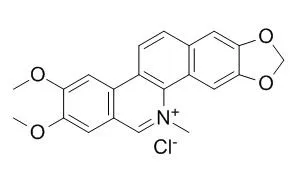| Cell Research: |
| Tumour Biol. 2014 Oct;35(10):10201-12. | | Nitidine chloride induces apoptosis, cell cycle arrest, and synergistic cytotoxicity with doxorubicin in breast cancer cells.[Pubmed: 25027404] | Medicinal plant extracts have been widely used for cancer treatment. Nitidine chloride (NC) is a natural bioactive alkaloid that has recently been reported to have diverse anticancer properties.
We aimed to investigate the cytotoxic effects of NC and the effectiveness of combinatorial treatment including NC and doxorubicin in breast cancer cells.
METHODS AND RESULTS:
Using MTT and flowcytometry assays, we found that NC induced cell growth inhibition and G2/M cell cycle arrest in a time- and dose-dependent manner both in MCF-7 and MDA-MB-231 breast cancer cell lines. Cancer cell growth inhibition was associated with increased levels of the p53 and p21 proteins. Apoptosis induction by NC treatment was confirmed by JC-1 mitochondrial membrane potential, annexin V-positive cell, and TUNEL staining. Using western blot analysis, we found that NC upregulated the pro-apoptotic proteins Bax, cleaved caspase-9 and -3 and cleaved PARP and that it downregulated the anti-apoptotic proteins Bcl-2 and PARP. By using the PI3K/Akt inhibitor LY294002, we further demonstrated that NC-induced apoptosis might be Akt-specific or dependent. In addition, NC exhibited a synergistic effect with doxorubicin on the growth inhibition of the human breast cancer cell lines MCF-7 and MDA-MB-231.
CONCLUSIONS:
Our study demonstrated the anticancer effect of NC on breast cancer and highlighted the potential clinical application of NC. | | Oncol Rep. 2015 Mar;33(3):1264-74. | | Nitidine chloride induces apoptosis in human hepatocellular carcinoma cells through a pathway involving p53, p21, Bax and Bcl-2.[Pubmed: 25530218] | Nitidine chloride (NC), a novel benzo[c]phenanthridine alkaloid, induces the growth inhibition of cancer cells. Previously it was demonstrated that SMMC-7721 human hepatocellular carcinoma (HCC) cells are highly susceptible to the antiproliferative effects of NC. However, the specific mechanisms remained unclear.
In the present study the pathways of growth inhibition induced by NC in SMMC-7721 cells were investigated.
METHODS AND RESULTS:
The effects of NC on SMMC-7721 cell proliferation were characterized by MTT and colony formation assays. Additionally, BALB/c nude mice were transplanted with SMMC-7721 cells to verify the inhibition of HCC by NC in vivo. The results showed that NC inhibited the proliferation of SMMC-7721 cells in vitro in a time- and dose-dependent manner and identified efficacy in vivo in a mouse model of HCC. Acridine orange (AO) staining, transmission electron microscopy, Annexin V/PI staining, TUNEL assay and caspase-3 activation assays were used to investigate apoptosis and the cell cycle distribution. Inhibition was mediated in part by cell cycle arrest in G2/M, leading to chromatin condensation, DNA fragmentation and the formation of apoptotic bodies. Apoptosis was also verified by Annexin V/PI staining, TUNEL assay and caspase-3 activation. To assess the levels of the cell cycle and apoptotic regulators, immunohistochemical staining, ELISA, real-time PCR and RNA interference (RNAi) were employed. The apoptotic process triggered by NC involved the upregulation of p53, p21 and Bax, and the downregulation of Bcl-2.
CONCLUSIONS:
These data elucidate a pathway of apoptosis in SMMC‑7721 cells that involves G2/M arrest, upregulation of p53, Bax, caspase-3 and p21, and downregulation of Bcl-2. |
|
| Animal Research: |
| Chinese Journal of Clinical Rehabilitation, 2006, 10(27):171-4. | | Protective effects of nitidine chloride on rats during myocardial ischemia/reperfusion.[Reference: WebLink] | | ①1 and 2 mg/kg Nitidine chloride can reduce the incidence rate of cardiac arrhythmia in rats with myocardial ischemia and reperfusion, postpone the emergence time of cardiac arrhythmia and shorten its duration, decrease the degree of ST segment elevation after reperfusion for 15 minutes and 60 minutes, which have similar effect with verapamil. ②1 and 2 mg/kg Nitidine chloride can reduce the release of myocardial enzyme, relieve the severity of oxygen-derived free radicals injury, and has the effect of protecting myocardial injury during ischemia-reperfusion, in which represents a dose-dependent effect. |
|






 Cell. 2018 Jan 11;172(1-2):249-261.e12. doi: 10.1016/j.cell.2017.12.019.IF=36.216(2019)
Cell. 2018 Jan 11;172(1-2):249-261.e12. doi: 10.1016/j.cell.2017.12.019.IF=36.216(2019) Cell Metab. 2020 Mar 3;31(3):534-548.e5. doi: 10.1016/j.cmet.2020.01.002.IF=22.415(2019)
Cell Metab. 2020 Mar 3;31(3):534-548.e5. doi: 10.1016/j.cmet.2020.01.002.IF=22.415(2019) Mol Cell. 2017 Nov 16;68(4):673-685.e6. doi: 10.1016/j.molcel.2017.10.022.IF=14.548(2019)
Mol Cell. 2017 Nov 16;68(4):673-685.e6. doi: 10.1016/j.molcel.2017.10.022.IF=14.548(2019)